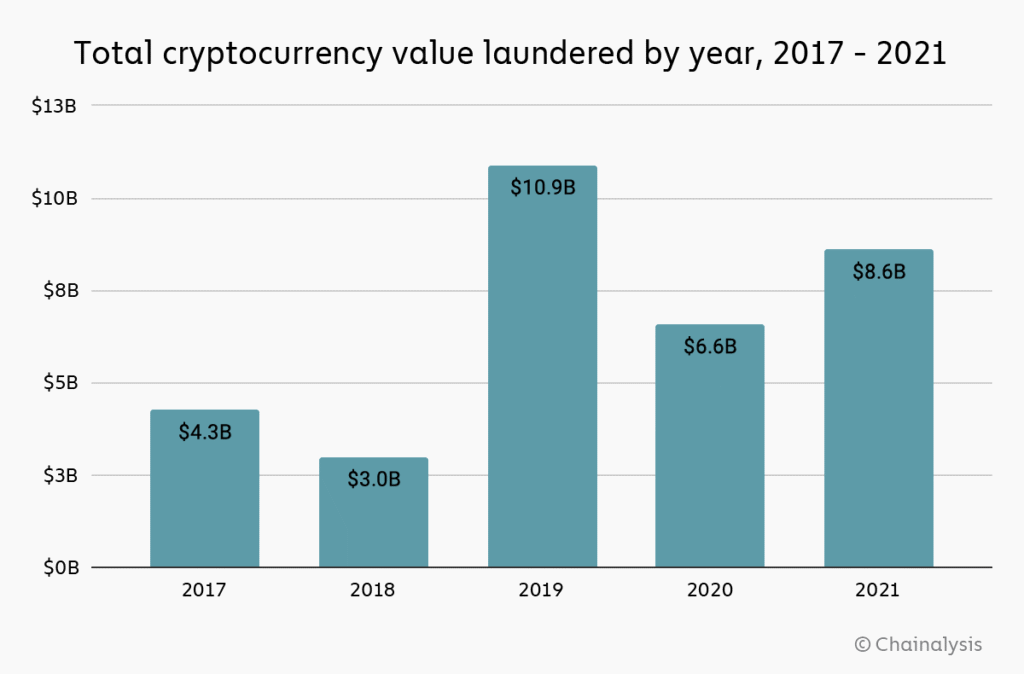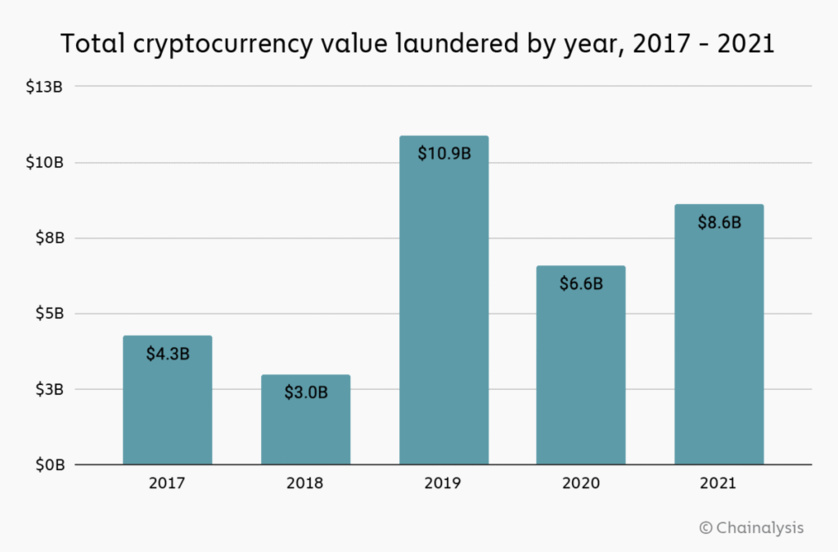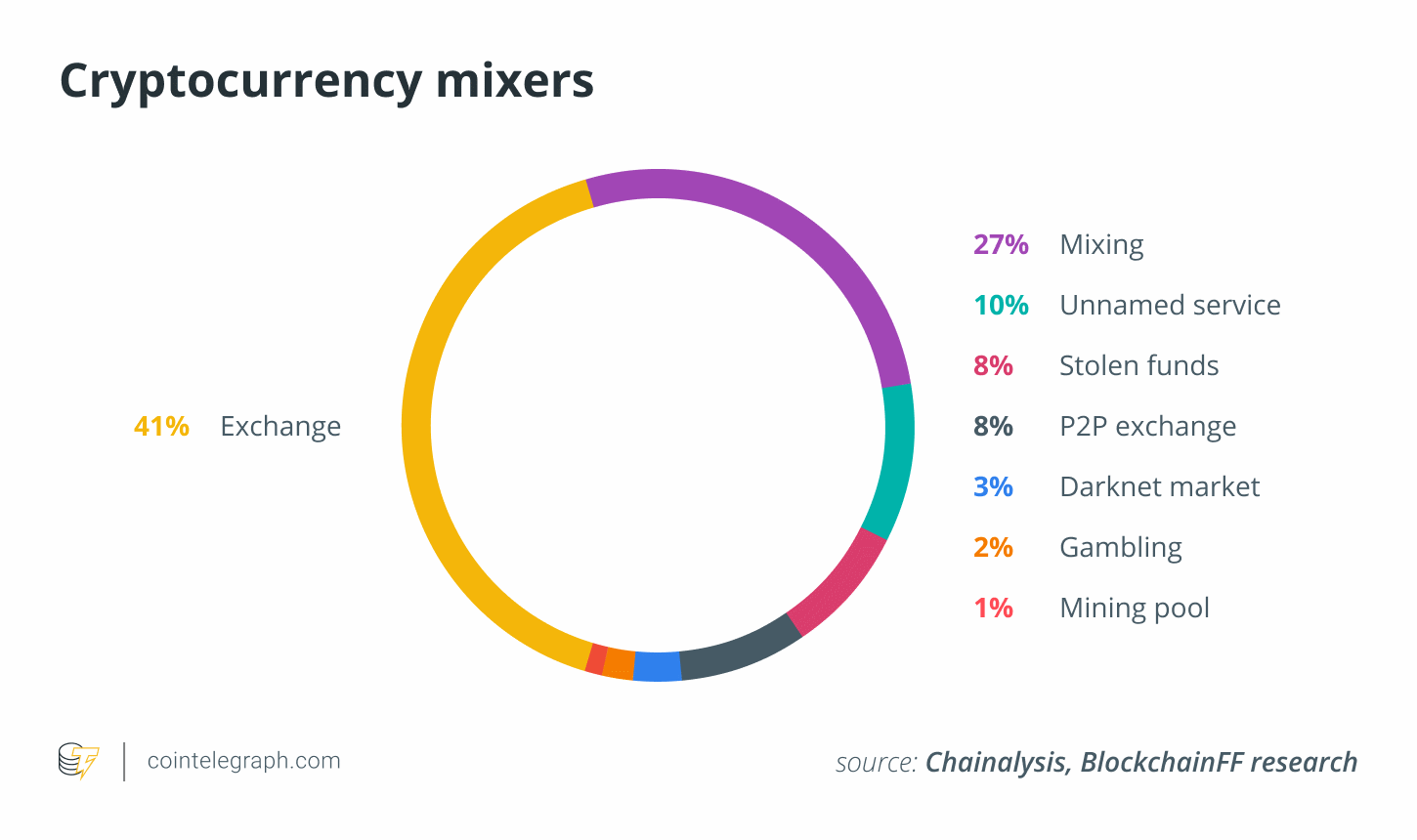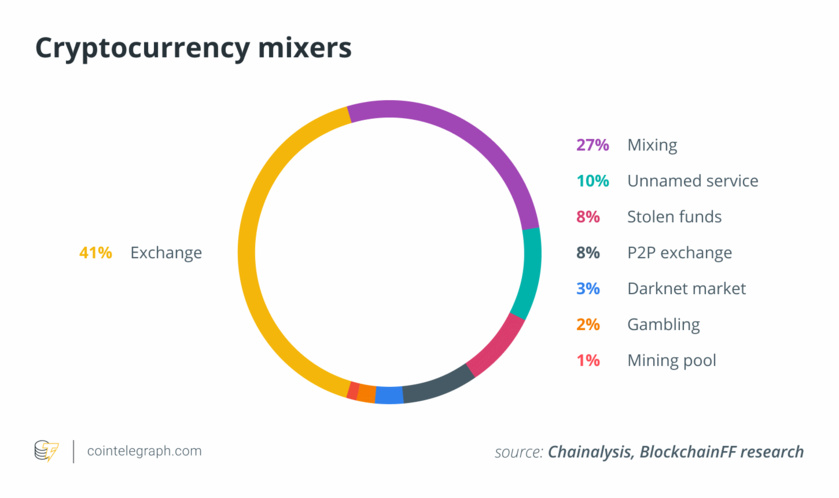
IMAGE SOURCE
Crypto crimes are on the rise. Last year, scammers took home a record $14 billion in cryptocurrency. Criminals laundered $8.6 billion worth of cryptocurrency in 2021, up by 30% from the previous year, based on a report by Chainalysis. On February 8, the Justice Department announced that it seized more than $3.6 billion in stolen cryptocurrency linked to the 2016 hack of Bitfinex. The authorities arrested a New York couple, Ilya Lichtenstein and his wife Heather Morgan, on charges they were conspiring to launder billions of dollars in bitcoin. Money laundering is one of the most prominent activities in the crypto market. While these activities are on the rise, laundering crypto is not something new. Moving illicit funds to a safe place, so they can eventually be “cleaned”, has been the common goal for the majority of the cybercriminals dealing in cryptocurrency. But unlike traditional bank robberies with criminals anonymously moving cash and re-entering it back into the system in different ways, bitcoin never leaves the system, and transactions are publicly visible, so moving stolen coins poses a risk of revealing who is behind the heist.
As Jameson Lopp points out, there are five primary security threat models against bitcoin holders: accidental loss, digital theft, government seizure, physical theft, and Inheritance planning.
Digital theft is a fast-growing enterprise. The rise of the crypto economy and decentralized finance, coupled with record cryptocurrency prices in 2021, has provided criminals with lucrative opportunities.
The 2022 Crypto Crime Report by Chainalysis, shows that cryptocurrency-based crime hit a new all-time high in 2021, with illicit addresses receiving $14 billion over the course of the year, up from $7.8 billion in 2020.
Crypto criminals are becoming the new crypto whales, as they now account for roughly 4% of all whales in the industry and hold a total of $25bn worth of cryptocurrency. They can certainly steal it but can they really clean it?
With the rapid growth of innovations in the crypto industry, criminals don’t have to look very far to find the technology they need for their cyberattacks and ransomware, committing thefts and scams, and laundering the proceeds of their crimes. Overall, since 2017 cybercriminals have laundered more than $33 billion worth of crypto.
That may sound like a big number, but in the six years since the hack, Ilya Lichtenstein and Heather Morgan roughly laundered only 20% of the total loot, 25,000 BTC, and still had access to another 94,000 of the stolen bitcoins.
Crypto crimes are on the rise. Last year, scammers took home a record $14 billion in cryptocurrency. Criminals laundered $8.6 billion worth of cryptocurrency in 2021, up by 30% from the previous year, based on a report by Chainalysis. On February 8, the Justice Department announced that it seized more than $3.6 billion in stolen cryptocurrency linked to the 2016 hack of Bitfinex. The authorities arrested a New York couple, Ilya Lichtenstein and his wife Heather Morgan, on charges they were conspiring to launder billions of dollars in bitcoin. Money laundering is one of the most prominent activities in the crypto market. While these activities are on the rise, laundering crypto is not something new. Moving illicit funds to a safe place, so they can eventually be “cleaned”, has been the common goal for the majority of the cybercriminals dealing in cryptocurrency. But unlike traditional bank robberies with criminals anonymously moving cash and re-entering it back into the system in different ways, bitcoin never leaves the system, and transactions are publicly visible, so moving stolen coins poses a risk of revealing who is behind the heist.
As Jameson Lopp points out, there are five primary security threat models against bitcoin holders: accidental loss, digital theft, government seizure, physical theft, and Inheritance planning.
Digital theft is a fast-growing enterprise. The rise of the crypto economy and decentralized finance, coupled with record cryptocurrency prices in 2021, has provided criminals with lucrative opportunities.
The 2022 Crypto Crime Report by Chainalysis, shows that cryptocurrency-based crime hit a new all-time high in 2021, with illicit addresses receiving $14 billion over the course of the year, up from $7.8 billion in 2020.
Crypto criminals are becoming the new crypto whales, as they now account for roughly 4% of all whales in the industry and hold a total of $25bn worth of cryptocurrency. They can certainly steal it but can they really clean it?
With the rapid growth of innovations in the crypto industry, criminals don’t have to look very far to find the technology they need for their cyberattacks and ransomware, committing thefts and scams, and laundering the proceeds of their crimes. Overall, since 2017 cybercriminals have laundered more than $33 billion worth of crypto.
That may sound like a big number, but in the six years since the hack, Ilya Lichtenstein and Heather Morgan roughly laundered only 20% of the total loot, 25,000 BTC, and still had access to another 94,000 of the stolen bitcoins.
A detailed blog post by Elliptic gives a full account of how the proceeds of the 2016 Bitfinex hack were laundered through darknet markets and privacy wallets.
Laundering crypto is not a walk in the park.
Bitcoin transactions are recorded on the blockchain for anyone to see. This is a problem for criminals since it means that law enforcement can follow the money trail using blockchain analytics tools, and can potentially trace the transactions to real people and lead to their arrest. It also makes it difficult to cash out proceeds of crime in bitcoin, because regulated financial institutions also use blockchain analytics tools, to identify any deposits that have originated from illegal activity.
In 2017, the couple started to move small amounts of stolen bitcoin. To “clean” their bitcoin, they used Alphabay, a marketplace on the dark web that is used to buy and sell drugs, weapons, and other illegal goods. By using Alphabay, the trail would run cold and the launderers could then simply deposit their bitcoin into another wallet, as its origin was wiped clean.
Launderers use mixers, services that allow users to deposit bitcoin and then withdraw different bitcoin from the pool, which effectively breaks the blockchain trail. Mixers are big business with over $2 billion in bitcoin sent through mixers. Perhaps the best example is the case of Larry Dean Harmon, of Ohio. Harmon operated a company called Helix, a bitcoin mixer that advertised its services on Harmon’s darknet-based search engine, Grams. Harmon also created a network of partners who used Helix to send bitcoin to each other incognito, paying Harmon a fee. Over three years, Helix laundered over 350,000 bitcoin, which with today’s prices would be valued at around $14 billion dollars. But mixers have some problems. You have to trust that it isn’t a service maintained by law enforcement or that it simply won’t disappear with the deposited bitcoins.
Laundering crypto is not a walk in the park.
Bitcoin transactions are recorded on the blockchain for anyone to see. This is a problem for criminals since it means that law enforcement can follow the money trail using blockchain analytics tools, and can potentially trace the transactions to real people and lead to their arrest. It also makes it difficult to cash out proceeds of crime in bitcoin, because regulated financial institutions also use blockchain analytics tools, to identify any deposits that have originated from illegal activity.
In 2017, the couple started to move small amounts of stolen bitcoin. To “clean” their bitcoin, they used Alphabay, a marketplace on the dark web that is used to buy and sell drugs, weapons, and other illegal goods. By using Alphabay, the trail would run cold and the launderers could then simply deposit their bitcoin into another wallet, as its origin was wiped clean.
Launderers use mixers, services that allow users to deposit bitcoin and then withdraw different bitcoin from the pool, which effectively breaks the blockchain trail. Mixers are big business with over $2 billion in bitcoin sent through mixers. Perhaps the best example is the case of Larry Dean Harmon, of Ohio. Harmon operated a company called Helix, a bitcoin mixer that advertised its services on Harmon’s darknet-based search engine, Grams. Harmon also created a network of partners who used Helix to send bitcoin to each other incognito, paying Harmon a fee. Over three years, Helix laundered over 350,000 bitcoin, which with today’s prices would be valued at around $14 billion dollars. But mixers have some problems. You have to trust that it isn’t a service maintained by law enforcement or that it simply won’t disappear with the deposited bitcoins.
A majority of Helix’s transactions were on AlphaBay. But, when Alphabay was shut down, Ilya and Heather moved money through Hydra, a Russian-based darknet marketplace, and also used “coinjoin” transactions on the Wasabi Wallet, a privacy wallet designed to prevent blockchain tracing. A coinjoin transaction is a special type of bitcoin transaction that combines transactions from multiple users into a single transaction with multiple inputs and outputs. Privacy wallets like Wasabi and JoinMarket make it easy for people to connect and make coinjoin transactions.
The couple’s also used “chain-hopping,” transferring funds from one cryptocurrency to another to make them more difficult to follow, including exchanging bitcoins for “privacy coins” like Monero and Dash.
But as more money pours into cryptocurrency crimes and scams, government agencies are increasingly cracking down and using sophisticated tracking tools that can track transactions on different chains. TRM Labs has developed a tool to fight “chain-hopping,” used by launderers to move funds across different blockchains.
The goal of money laundering is to create a path of transactions that can’t be traced. The argument that Bitcoin is a better tool to launder money is a misconception. Since the bitcoin blockchain is designed to have an indelible public record of all transactions, it makes laundering difficult.
Tracking Lichtenstein and Morgan is not only a great feat for the authorities but also testament that bitcoin is not anonymous. Bitcoin and many other cryptocurrencies operate pseudonymously but not anonymously, unlike cash. Transaction activity can still be viewed and tracked on the blockchain. If you know what to look for, you can connect the dots.
The other thing is that market participants have matured significantly. Because crypto is under scrutiny from regulators, most cryptocurrency exchanges and other on and off-ramps between crypto have KYC agreements. On the other hand leaked data shows that Swiss bank Credit Suisse held accounts valued at more than $100 billion for sanctioned individuals accused of money laundering.
Crypto may get the negative press. but the truth is that it takes a high degree of sophistication to move crypto around privately, and cashing out stolen funds is a very difficult proposition. You’re better off doing with the existing financial system and not public blockchains.
The couple’s also used “chain-hopping,” transferring funds from one cryptocurrency to another to make them more difficult to follow, including exchanging bitcoins for “privacy coins” like Monero and Dash.
But as more money pours into cryptocurrency crimes and scams, government agencies are increasingly cracking down and using sophisticated tracking tools that can track transactions on different chains. TRM Labs has developed a tool to fight “chain-hopping,” used by launderers to move funds across different blockchains.
The goal of money laundering is to create a path of transactions that can’t be traced. The argument that Bitcoin is a better tool to launder money is a misconception. Since the bitcoin blockchain is designed to have an indelible public record of all transactions, it makes laundering difficult.
Tracking Lichtenstein and Morgan is not only a great feat for the authorities but also testament that bitcoin is not anonymous. Bitcoin and many other cryptocurrencies operate pseudonymously but not anonymously, unlike cash. Transaction activity can still be viewed and tracked on the blockchain. If you know what to look for, you can connect the dots.
The other thing is that market participants have matured significantly. Because crypto is under scrutiny from regulators, most cryptocurrency exchanges and other on and off-ramps between crypto have KYC agreements. On the other hand leaked data shows that Swiss bank Credit Suisse held accounts valued at more than $100 billion for sanctioned individuals accused of money laundering.
Crypto may get the negative press. but the truth is that it takes a high degree of sophistication to move crypto around privately, and cashing out stolen funds is a very difficult proposition. You’re better off doing with the existing financial system and not public blockchains.

Ilias Louis Hatzis
Ilias Louis Hatzis is the Founder & CEO at Mercato Blockchain Corporation AG.
Ilias Louis Hatzis is the founder and CEO at Kryptonio wallet. Create your wallet in less than a minute, without seed phrases, private keys, passwords or documents. Keep your bitcoin and digital assets always secure and recoverable: https://kryptonio.com
I have no positions or commercial relationships with the companies or people mentioned. I am not receiving compensation for this post.
Ilias Louis Hatzis is the founder and CEO at Kryptonio wallet. Create your wallet in less than a minute, without seed phrases, private keys, passwords or documents. Keep your bitcoin and digital assets always secure and recoverable: https://kryptonio.com
I have no positions or commercial relationships with the companies or people mentioned. I am not receiving compensation for this post.
Autres articles
-
La fintech hero obtient son agrément d'Etablissement de Paiement
-
Les meilleurs meme coins de Solana en novembre 2024 - Les 3 meilleurs choix de l'analyste
-
Initiation de paiement : Une solution innovante pour réduire les coûts et améliorer la sécurité des transactions pour les DAF
-
Leetchi s'émancipe un peu plus de Mangopay avec le rachat d'iRaiser
-
Nominations | Banque Hottinguer renforce ses équipes dédiée à la Gestion privée




















